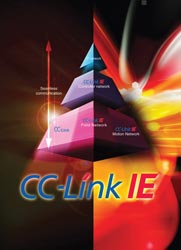
Posted to News on 11th Oct 2010, 22:47
CC-Link survives in harsh die casting environment
CC-Link has proven to be a more reliable and cost-effective alternative to conventional wiring on die casting machines with cables that have to flex on every machine cycle.

An American die casting company that ran a year-long trial of CC-Link communications for machine control in a harsh environment - and experienced no problems whatsoever - has now rolled out the technology across its facility in Columbus, Indiana, and a second works in Jacksonville, Florida.
In each of Enkei America's casting machines, all control wires ran through a single conduit. The content of this conduit built up over the years until it contained about 75 wires. Significantly the conduit was flexible, because it is required to repeatedly bend to accommodate the vertical movement of the casting machines.
Unfortunately extended operation of the machines, coupled with the weight of the wires, would cause the conduit to break after a period of time. This resulted in chafing of the wires and, eventually, the wire insulation would be damaged, causing shorting of the wires. This situation presented a continual maintenance problem.
In an attempt to eliminate the breaking of the conduit, a different style of conduit was tried; it was supposed to be able to handle the weight of the wires and the travel of the conduit, but this conduit also failed. These repeated breakages meant that the machines had to be rewired, which required about 10-12 hours of machine downtime each time, as well as and lost production and over 300m (1000 feet) of high-temperature wire. Additional problems also arose, such as the junction boxes on all of the machines becoming very cramped due to the numerous updates performed on the machines.
CC-Link and remote I/O
Looking for a solution to this problem beyond repeated repairs, Enkei installed its first CC-Link networked machine as a trial. This used a Mitsubishi controller and CC-Link remote I/O modules, plus an expansion rack and junction boxes to accommodate the remote I/O modules.
CC-Link, being a fieldbus technology, enables multiple cables within the conduit to be replaced with a single bus cable that transmits both power and signals to all devices (the signalling speed is such that there is no reduction in systems performance compared to dedicated wiring.)
Benefits of the new CC-Link system were seen immediately. For instance, the junction boxes became much neater and more organised, while the single CC-Link communication cable that replaced much of the wiring previously required lead to efficiency gains in maintenance. Value was also seen in the fact that future updates can be accommodated by adding a new remote I/O module without needing additional wiring back to the controller.
Even after CC-Link networking was employed, the casting machine still required some movable wiring and conduit. A loom was added to help provide protection and more stable travel of the cable. Pin connectors were added on both ends of the cable for quick replacement in the event of a cable breakage. The pin connector has the CC-Link signal wires and 24V control voltage. Pin connectors were also used for 120V wires for the valves on the machine.
Reliability and simplified maintenance
The first machine using CC-Link networking and Mitsubishi controls operated during the initial year-long evaluation period and experienced no problems. The die casting environment is harsh, with high temperatures, water, die coat and dust - yet the system operated trouble-free. If necessary, a casting machine can be rewired in about thirty minutes using spare cables that have been assembled and stored ready for installation. The cost to rewire is considerably less than before, and that is not even factoring in the cost of only 30 minutes of downtime versus the 10-12 hours previously required.
After the success of the first machine, Enkei retrofitted seven more casting machines use to CC-Link networking. Enkei has also been extremely pleased with the durability of the CC-Link communication cable. The casting machines run a cycle time of three minutes and, on every cycle, the loom travels down and then back up. There have been no problems with cable chafing or broken wires.
Enkei has now also installed CC-Link and Mitsubishi controls on casting machines at its plant in Jacksonville, Florida. With the ease of programming, simple and minimal wiring, and the overall satisfaction of the CC-Link networking, Enkei plans in future to use CC-Link networking in all applications that it can.
Want the latest machine building news straight to your inbox? Become a MachineBuilding member for free today >>

















